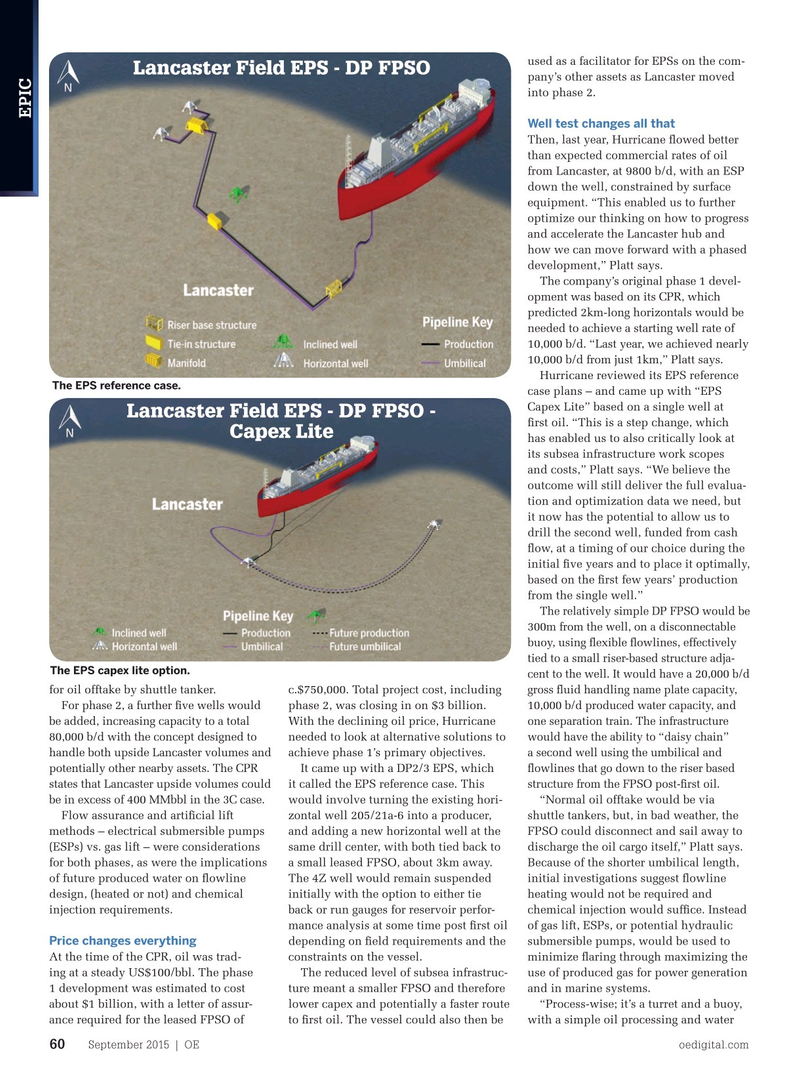
Page 58: of Offshore Engineer Magazine (Sep/Oct 2015)
Read this page in Pdf, Flash or Html5 edition of Sep/Oct 2015 Offshore Engineer Magazine
used as a facilitator for EPSs on the com- clean-up system,” Platt says. Hurricane
Lancaster Field EPS - DP FPSO pany’s other assets as Lancaster moved hopes to be able to discharge any pro- into phase 2. duced water over the side. “Hurricane has also started discussions
EPIC
Well test changes all that with a number of FPSO providers for a
Then, last year, Hurricane fowed better fnancial solution, which would not rely than expected commercial rates of oil on traditional bank fnancing routes to from Lancaster, at 9800 b/d, with an ESP help solve its conundrum of having to down the well, constrained by surface collateralize a letter of assurance to the equipment. “This enabled us to further FPSO provider,” Platt says. optimize our thinking on how to progress
Phase 2, “Post-EPS Capex Lite” and accelerate the Lancaster hub and
What the new phase 2 would look like is how we can move forward with a phased still undecided. “It could be that Hurricane development,” Platt says. goes direct from the “EPS Capex Lite” to a
The company’s original phase 1 devel- full feld development in one go, or via the opment was based on its CPR, which
CPR concept of phase 1 through to a full predicted 2km-long horizontals would be feld development,” Platt says. needed to achieve a starting well rate of 10,000 b/d. “Last year, we achieved nearly Hurricane also has more than the 10,000 b/d from just 1km,” Platt says. Lancaster feld to consider. The nearby
Hurricane reviewed its EPS reference Lincoln feld has a P50 prospective The EPS reference case.
case plans – and came up with “EPS resource of 150 MMbbl, which could
Capex Lite” based on a single well at pave the way for a Greater Lancaster Area
Lancaster Field EPS - DP FPSO - frst oil. “This is a step change, which (GLA) hub development.
Capex Lite has enabled us to also critically look at There is also Whirlwind, with a 200 its subsea infrastructure work scopes MMbbl 2C contingent resource in the oil and costs,” Platt says. “We believe the case. However, Whirlwind might require a outcome will still deliver the full evalua- platform-based solution to host compres- tion and optimization data we need, but sion supported by the GLA hub FPSO, as it now has the potential to allow us to analysis of the Whirlwind discovery well drill the second well, funded from cash fow, at a timing of our choice during the initial fve years and to place it optimally, based on the frst few years’ production from the single well.”
The relatively simple DP FPSO would be 300m from the well, on a disconnectable buoy, using fexible fowlines, effectively tied to a small riser-based structure adja-
The EPS capex lite option.
cent to the well. It would have a 20,000 b/d for oil offtake by shuttle tanker. c.$750,000. Total project cost, including gross fuid handling name plate capacity,
For phase 2, a further fve wells would phase 2, was closing in on $3 billion. 10,000 b/d produced water capacity, and be added, increasing capacity to a total
With the declining oil price, Hurricane one separation train. The infrastructure 80,000 b/d with the concept designed to needed to look at alternative solutions to would have the ability to “daisy chain” handle both upside Lancaster volumes and achieve phase 1’s primary objectives. a second well using the umbilical and potentially other nearby assets. The CPR
It came up with a DP2/3 EPS, which fowlines that go down to the riser based states that Lancaster upside volumes could it called the EPS reference case. This structure from the FPSO post-frst oil.
be in excess of 400 MMbbl in the 3C case. would involve turning the existing hori- “Normal oil offtake would be via
Flow assurance and artifcial lift zontal well 205/21a-6 into a producer, shuttle tankers, but, in bad weather, the methods – electrical submersible pumps and adding a new horizontal well at the FPSO could disconnect and sail away to (ESPs) vs. gas lift – were considerations same drill center, with both tied back to discharge the oil cargo itself,” Platt says. for both phases, as were the implications a small leased FPSO, about 3km away. Because of the shorter umbilical length, of future produced water on fowline The 4Z well would remain suspended initial investigations suggest fowline design, (heated or not) and chemical initially with the option to either tie heating would not be required and injection requirements. back or run gauges for reservoir perfor- chemical injection would suffce. Instead mance analysis at some time post frst oil of gas lift, ESPs, or potential hydraulic
Price changes everything depending on feld requirements and the submersible pumps, would be used to
At the time of the CPR, oil was trad- constraints on the vessel. minimize faring through maximizing the ing at a steady US$100/bbl. The phase The reduced level of subsea infrastruc- use of produced gas for power generation 1 development was estimated to cost ture meant a smaller FPSO and therefore and in marine systems. about $1 billion, with a letter of assur- lower capex and potentially a faster route “Process-wise; it’s a turret and a buoy, ance required for the leased FPSO of to frst oil. The vessel could also then be with a simple oil processing and water
September 2015 | OE oedigital.com 60 058-OE0915_EPIC2_Hurricane.indd 60 8/20/15 10:48 AM

 57
57

 59
59